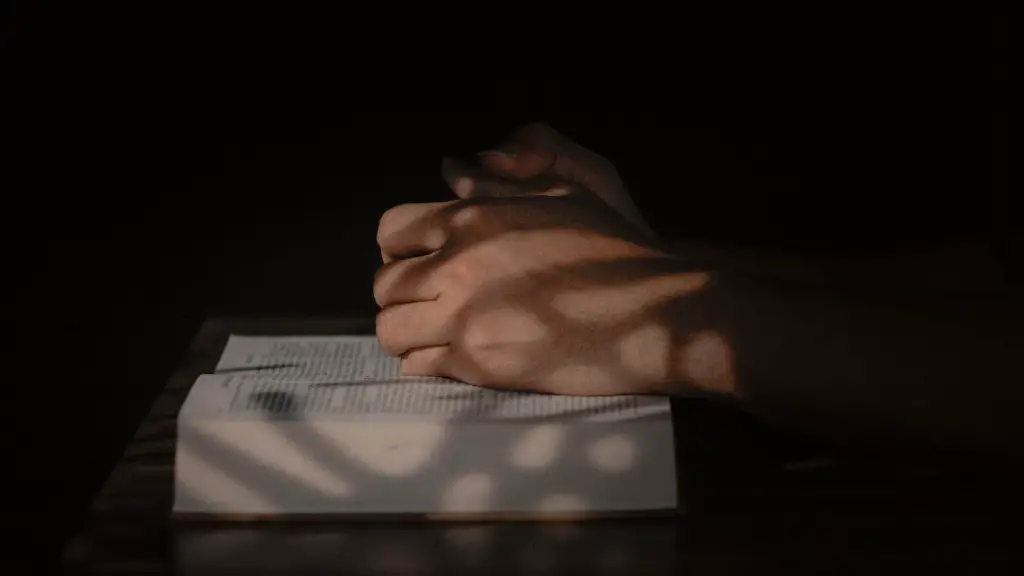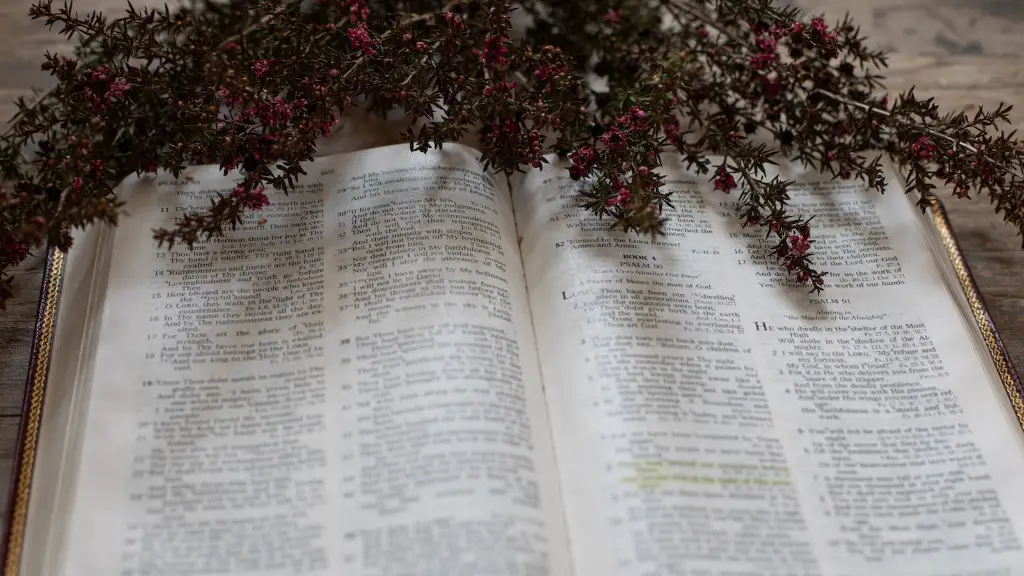Is The Hail Mary Prayer In The Bible?
The Hail Mary prayer is a prayer of supplication to the Virgin Mary, the mother of Jesus. It is a very popular prayer among Roman Catholics and other Christian denominations. The prayer originates from the book of Luke in the New Testament of the Bible. However, there is some debate about whether or not the Hail Mary prayer is actually found in the Bible.
The prayer is also known as the Ave Maria. It is made up of three sentences and starts with “Hail Mary, full of grace, the Lord is with thee.” This is then followed by “Blessed art thou among women, and blessed is the fruit of thy womb, Jesus.” The prayer concludes with “Holy Mary, mother of God, pray for us sinners now and at the hour of our death. Amen.” There is no mention of the Hail Mary prayer in either the Old Testament or the New Testament of the Bible.
Most Christians believe that the Hail Mary prayer is derived from the Angel Gabriel’s announcement to Mary, when he told her that she would give birth to the son of God. In the Bible, it is written in Luke 1:28, “And the angel answered and said unto her, ‘Hail, thou that art highly favoured, the Lord is with thee: blessed art thou among women.” This phrase forms the first sentence of the Hail Mary prayer.
The other two sentences of the prayer are not a direct quote from the Bible, although they are based on scripture. The second sentence is thought to be derived from verse 42, where Elizabeth, Mary’s cousin, gives praise to Mary for the child she carries. The third sentence is believed to be based on the Magnificat, a song of praise and admiration of God, which Mary delivers in her own words in Luke 1:46–55.
There is no direct reference in the Bible to Mary being the mother of God, although the Bible does refer to Jesus as being the son of God. Some Christians believe that the third sentence of the Hail Mary prayer was added by the early Christian church as a declaration of Mary’s motherhood. In the Roman Catholic Church, the belief is that Mary was “ever-virgin” and that she was the mother of Jesus not only physically but spiritually, and so the third sentence of the Hail Mary prayer is seen as an affirmation of this belief.
In conclusion, the Hail Mary prayer is based on phrases and scripture that can be found in the Bible, but it is not directly mentioned in the Bible itself. Whether or not it is appropriate to include the prayer in religious activities is up to individual interpretation and belief.
Background of The Hail Mary Prayer
The Hail Mary prayer is a centuries-old prayer that dates back to at least the fifth century. The exact origins of the prayer are not known, but the earliest version of it was found in a book written in the ninth century by a German monk named St. Rabanus Maurus. Since then, the prayer has existed in various versions in multiple languages, and it has been included in many religious texts throughout the centuries.
The Hail Mary prayer has been used in many different contexts, from private devotions to special religious ceremonies. It is a very important prayer for Roman Catholics, who pray it as part of their daily devotions, as the prayer is seen to be of special importance to Mary, the mother of Jesus. It is also used in special religious ceremonies, such as baptisms and weddings, when the person being baptized or married is asked to recite the prayer along with the officiating clergy.
In recent times, the Hail Mary prayer has been used as a form of protest against certain social issues. For example, in the United States, a group of Catholic nuns known as the “Nuns on the Bus” staged a nationwide tour in 2012 and 2013 to protest policies related to immigration and poverty. As part of their tour, they prayed the Hail Mary prayer at each stop to show their devotion and their beliefs.
What does The Hail Mary Prayer mean?
The Hail Mary prayer is a beautiful and powerful way to express faith and devotion to Mary, the mother of Jesus. In the first sentence of the prayer, Mary is referred to as “full of grace”, underscoring the belief that she is the recipient of God’s special favour. This sentence also expresses the belief that Mary is a source of grace and mercy, and that by praying the Hail Mary prayer one can be blessed with Divine grace and mercy.
The second sentence of the prayer expresses belief in Mary’s special place amongst women, and acknowledges her special relationship with Jesus. In the third sentence, the prayer turns to a plea for prayers and intercession to be offered to God on behalf of all sinners. This sentence can be seen to be in line with the traditional Christian belief in the power of prayer and its importance in getting closer to God.
The Hail Mary prayer is a powerful testimony of faith and love for Mary, and it is seen by Christians as a way to become closer to God by invoking the presence of Mary, the mother of God.
How is The Hail Mary Prayer Used in Devotions?
The Hail Mary prayer is often used in Roman Catholic devotions, especially during rosary prayer circles. In Roman Catholic tradition, the prayer is joined by the Our Father prayer and the Glory Be prayer to form what is known as the Holy Rosary. This is a series of prayers that are recited on a cycle basis, and it is seen as a special devotion to Mary.
The Holy Rosary is a tradition that dates back to the late 14th century, when it is believed to have been first adopted by the Dominican Order. The prayers of the Rosary are interspersed with reflections on the life of Jesus and Mary, and they are said to be a way of spiritually connecting with Jesus and Mary. The Hail Mary is a key part of the Rosary, as it is repeated multiple times as the devotee prays for the intercession of Mary.
In addition to being used in Rosary devotions, the Hail Mary prayer is also used in daily devotions. This could include saying the prayer multiple times a day, or saying the prayer each time one passes a church or other religious building. It is also used as part of other devotional practices, such as novenas or litanies.
Contemporary Interpretations of The Hail Mary Prayer
In contemporary times, the Hail Mary prayer has taken on a different significance, with some interpreting it as a call to action to protect vulnerable people, particularly children. This interpretation is based on the belief that Mary was the protector of vulnerable people in the Bible, and that praying the Hail Mary prayer is a way of invoking her protection again.
The Hail Mary prayer has also been adopted by people from other spiritual backgrounds and beliefs. This can be seen in the many adaptations of the prayer, such as the Buddhist version of the Hail Mary prayer. This version includes references to Buddha and Tara and it is seen as a way to connect to the divine in an ecumenical way.
Overall, the Hail Mary prayer is one of the most significant and powerful prayers of the Christian faith, and it has been adapted and interpreted in a variety of ways in contemporary times. By reciting the prayer, it is believed that one can call on Mary’s special grace and intercession, and that it can be used to bring guidance and protection.
The Hail Mary Prayer in Modern Pop Culture
The Hail Mary prayer has become an important part of popular culture in recent years. It has been referenced in many different music genres, from rock and pop to hip hop and rap. In fact, the prayer is so popular that it is often referred to in song titles, such as “Hail Mary” by Tupac Shakur and “Hail Mary” by Mötley Crüe.
The Hail Mary prayer has also been featured in a range of different films and TV shows. In the popular comedy series The Office, for example, one of the characters, Dwight Schrute, recites the Hail Mary prayer in several episodes. Additionally, the prayer has been featured in a number of books and other literary works, as well as in comic books and other works of popular culture.
The Hail Mary prayer is also associated with a range of other religious and spiritual practices. For example, in the Sikh faith, the Hail Mary prayer is used as part of an energy practice known as Khechari. Similarly, in the Hindu tradition, the prayer is used in Yoga and meditation practices, as well as in Ayurvedic healing rituals.
In conclusion, the Hail Mary prayer has become an important part of religious devotions and popular culture in different genres and spiritual traditions. Its presence can be seen in many forms of art and literature, as well as in films, TV series, and in daily devotions.
Conclusion
The Hail Mary prayer is a very popular prayer among Roman Catholics and other Christian denominations. It is believed to be derived from the Angel Gabriel’s announcement to Mary, as well as from other verses of scripture that are found in the Bible. While the prayer is not mentioned in the Bible itself, it is based on phrases and scripture found in the Bible, and it is seen as a beautiful and powerful way to express faith and devotion to Mary, the mother of Jesus.
The prayer is often used in devotional practices, such as Rosary prayer circles, and it has been adopted and adapted by people from other spiritual backgrounds as well. Additionally, the Hail Mary prayer has become an important part of popular culture in recent years, with many references in different music genres, films and TV series, as well as literary works and other popular forms of culture.





